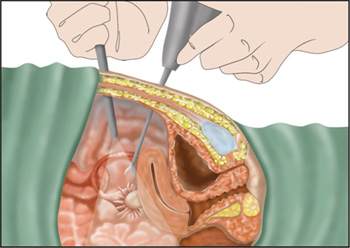Services
- Diagnostic Laparoscopy
- Endoscopic Procedures (Keyhole Surgery)
- Fastest Laparoscopic Procedures
- Hysteroscopic Surgeries
- Laparoscopic Fertility Promoting Surgery
- Laparoscopic Gynaecological Surgery
- Laparoscopic Hysterectomy
- Laparoscopic Operative Procedures
- Laparoscopic Reproductive Surgery
Laparoscopic Hysterectomy:
 A laparoscopic hysterectomy is a minimally invasive surgical procedure to remove the uterus. A small incision is made in the belly button and a tiny camera is inserted. The surgeon watches the image from this camera on a TV screen and performs the operative procedure. Two or three other tiny incisions are made in the lower abdomen. Specialized instruments are inserted and used for the removal process.
A laparoscopic hysterectomy is a minimally invasive surgical procedure to remove the uterus. A small incision is made in the belly button and a tiny camera is inserted. The surgeon watches the image from this camera on a TV screen and performs the operative procedure. Two or three other tiny incisions are made in the lower abdomen. Specialized instruments are inserted and used for the removal process.
Some women do not have their ovaries removed when they undergo a hysterectomy. If the ovaries stay inside, the woman does not need to take any hormones after the surgery and she does not have hot flashes. Some women remove their ovaries because of family history of ovarian cancer or they have an abnormal growth on their ovary.
Women can choose to either keep the cervix in place (called a “laparoscopic supra-cervical hysterectomy”) or remove the entire uterus and cervix (“total laparoscopic hysterectomy”).
Keeping the cervix in place makes the operation a little faster and safer. When the cervix is in place there is a 5% chance that the woman will have monthly spotting at the time of her menstrual periods. Women whose cervices stay in place need to continue getting pap smears.
If the woman wants to be 100% certain that she will never menstruate again, she needs to have the entire uterus removed. If the patient has a history of pre-cancerous changes of the cervix or uterine lining, she should have the entire uterus removed. If the operation is being done for endometriosis or pelvic pain, many doctors think the chances for pain reduction are better if the cervix is removed.
What are the advantages of a laparoscopic hysterectomy surgery ?
A laparoscopic hysterectomy requires only a few small incisions, compared to a traditional abdominal hysterectomy which is done through a 3-6 inch incision. As a result, there is less blood loss, less scarring and less post-operative pain. A laparoscopic hysterectomy is usually done as an outpatient procedure whereas an abdominal hysterectomy usually requires a 2-3 day hospital stay. The recovery period for this laparoscopic procedure is 1-2 weeks, compared to 4-6 weeks after an abdominal hysterectomy.
The risks of blood loss and infection are lower with laparoscopic hysterectomy than with an abdominal hysterectomy. In experienced hands, laparoscopic hysterectomy takes about the same length of time as an abdominal hysterectomy and involves no greater risk.
Who should have laparoscopic hysterectomy surgery ?
Most patients who are having a hysterectomy to treat abnormal uterine bleeding or fibroids can have a laparoscopic hysterectomy. It may not be possible in some cases. For example, if the uterus is bigger than a 4 month pregnancy, if she’s had multiple previous operations in her lower abdomen. It is usually not done for women with a gynecologic cancer.
What preparations will be needed prior to surgery ?
The surgeon may have the patient see their primary care doctor prior to surgery to make sure there are no medical conditions that may cause a problem with the surgery. There will be a pre-operative appointment prior to the day of surgery which will include a history and physical examination, blood samples, and a visit w a member of the anesthesia department. Patients should not eat or drink anything after midnight on the night before surgery.
What type of anesthesia will be required ?
Patients are put to sleep under general anesthesia.
Is there a hospital stay after surgery ?
The majority of our patients go home the same day as their surgery.
What kind of recovery can be expected ?
Patients should expect to take ibuprofen or narcotic pain pills for a few days post-operatively. We encourage patients NOT to stay in bed. They should move around the house and resume normal activities as soon as they feel up to it. Some women are well enough to return to work one week after surgery. Women who have more physically demanding work should stay home for 2-3 weeks. Women can resume exercise and sex within a few weeks of the surgery.
Laparoscopic patients can expect to suffer less post-operative pain than traditional hysterectomy or cesarean section patients.



